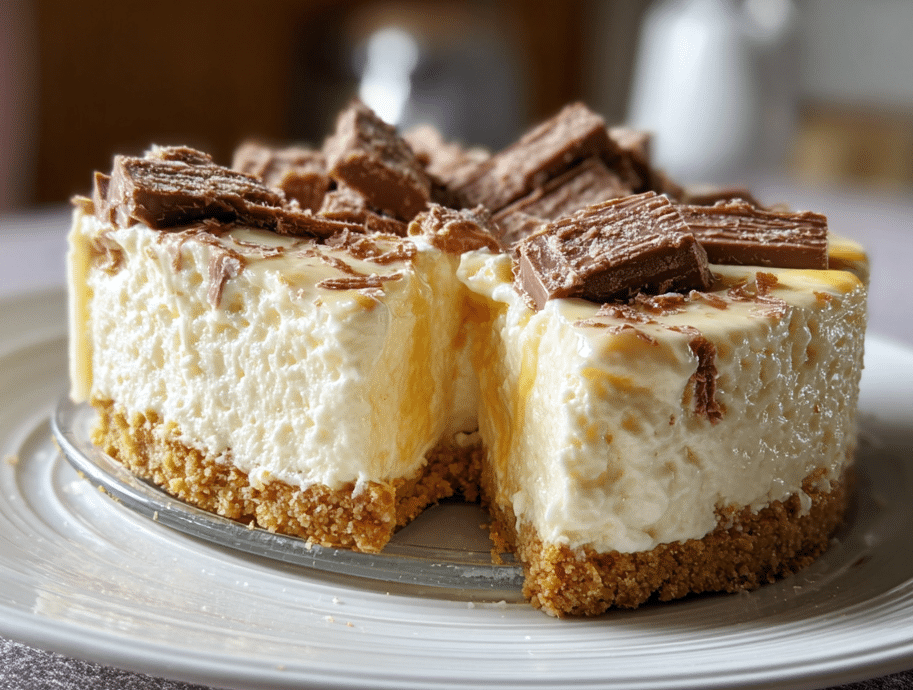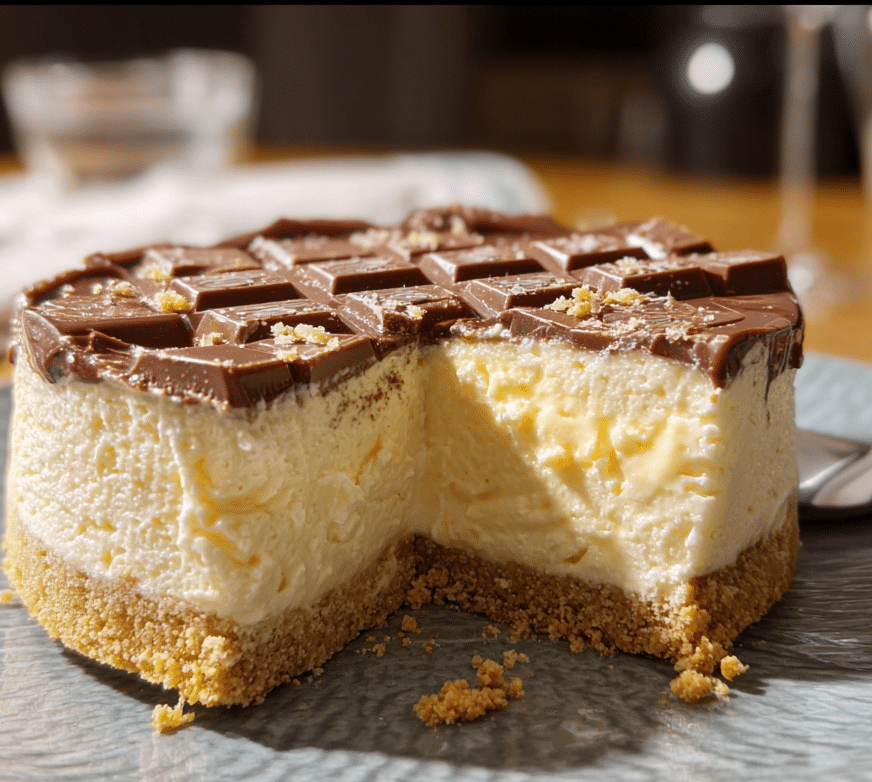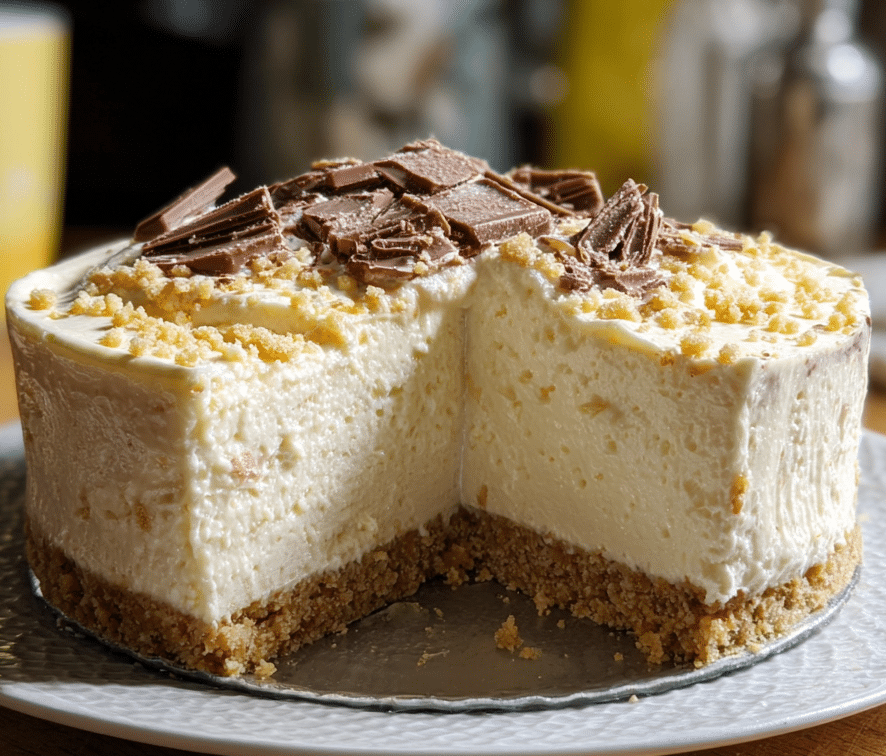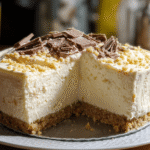Are you tired of dense, heavy cheesecakes that leave you feeling overwhelmed? Let me introduce you to the lemon ripple cheesecake – a light, refreshing dessert that combines creamy richness with bright citrus swirls that dance across every slice.
Hi there! I’m Lisa from Recipesrealm, and this lemon ripple cheesecake has become my signature dessert for spring gatherings and summer celebrations. I remember the first time I created this recipe – it was for my daughter’s graduation party, and guests couldn’t stop raving about the perfect balance of tangy lemon and velvety cream cheese. Since then, I’ve perfected every detail, from the buttery graham cracker crust to those gorgeous golden ripples that make each slice Instagram-worthy.
This recipe promises a cheesecake that’s impossibly smooth, never cracked, with a stunning marble effect that looks like it came from a high-end bakery. As someone who’s baked hundreds of cheesecakes over the years, I’ve mastered the techniques that prevent common disasters like cracks, sinking centers, and soggy crusts.
In this comprehensive guide, you’ll discover my best-kept secrets for selecting quality ingredients, creating the perfect ripple effect, achieving that silky texture, and troubleshooting any issues. Whether you’re preparing this for a special occasion or simply treating yourself, this lemon ripple cheesecake will become your go-to dessert recipe.
Why This Lemon Ripple Cheesecake Recipe Works
This lemon ripple cheesecake stands out from ordinary desserts for several compelling reasons:
- Uses accessible ingredients you likely have in your pantry – No exotic items or specialty store trips required. Simple cream cheese, fresh lemons, eggs, and graham crackers create magic together.
- Perfect for any skill level – Whether you’re a beginner baker or seasoned pro, my step-by-step instructions ensure foolproof results every single time.
- Make-ahead friendly for stress-free entertaining – Prepare this cheesecake up to three days in advance, giving you more time to enjoy your guests instead of being stuck in the kitchen.
- Stunning presentation with minimal effort – The ripple technique looks incredibly sophisticated but takes less than five minutes to master. Your guests will think you spent hours perfecting those beautiful swirls.
- Refreshing yet indulgent balance – The bright lemon cuts through the richness of cream cheese, creating a dessert that’s satisfying without being overwhelming. It’s the perfect ending to any meal.
- Versatile for all seasons and occasions – Serve it at Easter brunch, summer picnics, holiday dinners, or Tuesday night because you deserve something special.
Choosing the Right Ingredients for Lemon Ripple Cheesecake
The quality of your ingredients directly impacts the final result. Let me guide you through selecting the best components for your lemon ripple cheesecake.
Best Cream Cheese for This Recipe
The foundation of any exceptional cheesecake is premium cream cheese. For this lemon ripple cheesecake, full-fat brick-style cream cheese is non-negotiable. I exclusively use Philadelphia cream cheese because it has the perfect moisture content and smooth texture. Store brands often contain more water and stabilizers, which can lead to a grainy texture or excessive cracking.
Always use cream cheese at room temperature – this is crucial! Cold cream cheese creates lumps that won’t fully incorporate, resulting in a bumpy texture. Remove your cream cheese from the refrigerator at least two hours before baking, or cut it into cubes to speed up the warming process.
Lemon Selection Tips
Fresh lemons make all the difference in this lemon ripple cheesecake. Look for lemons that feel heavy for their size, indicating they’re juicy. The skin should be bright yellow with a slight give when gently squeezed. Avoid lemons with brown spots or overly hard skin.
You’ll need both lemon zest and juice for this recipe. Always zest your lemons before juicing them – it’s nearly impossible to zest a juiced lemon! Use a microplane grater for the finest zest without any bitter white pith. One medium lemon typically yields about one tablespoon of zest and three tablespoons of juice.
Graham Cracker Crust Essentials
For the crust of your lemon ripple cheesecake, traditional honey graham crackers provide the perfect sweet, slightly nutty base. You’ll need about 12 full graham cracker sheets (one and a half packages) to make enough crumbs. I prefer crushing them myself in a food processor rather than buying pre-made crumbs, as freshly crushed crackers have better texture and flavor.
The butter you use matters too. Unsalted butter gives you better control over the sweetness level. Melted butter should be warm but not hot, as excessive heat can make your crust greasy.
Substitutions for Dietary Needs
If you need to modify this lemon ripple cheesecake for dietary restrictions, here are tested alternatives. For gluten-free versions, use gluten-free graham crackers or substitute with almond flour crust (two cups almond flour mixed with quarter cup melted butter and two tablespoons sugar). For reduced sugar options, you can replace up to half the sugar with erythritol-based sweeteners, though the texture will be slightly different.

Ingredients & Prep for Lemon Ripple Cheesecake
Essential Ingredients List
For the Crust:
- 1¾ cups graham cracker crumbs (about 12 full sheets)
- ¼ cup granulated sugar
- 6 tablespoons unsalted butter, melted
- Pinch of salt
For the Cheesecake Filling:
- 32 ounces (four 8-ounce packages) cream cheese, room temperature
- 1¼ cups granulated sugar
- 1 tablespoon all-purpose flour
- 1 tablespoon vanilla extract
- 4 large eggs, room temperature
- ⅔ cup sour cream, room temperature
- ¼ cup heavy cream, room temperature
For the Lemon Ripple:
- ¾ cup fresh lemon juice (about 3-4 lemons)
- 2 tablespoons lemon zest
- ½ cup granulated sugar
- 3 large egg yolks
- 4 tablespoons unsalted butter, cut into pieces
- Pinch of salt
Preparation Essentials
Before starting your lemon ripple cheesecake, proper preparation prevents baking disasters. Remove all dairy ingredients from the refrigerator two hours before baking. Cold ingredients don’t blend smoothly and can create air pockets that lead to cracks.
Prepare your springform pan by wrapping the outside with two layers of heavy-duty aluminum foil. This waterproofs the pan for the water bath, which is essential for even baking. I wrap mine from the bottom up, ensuring the foil extends at least halfway up the sides.
Making the Lemon Curd
The lemon curd for your lemon ripple cheesecake should be made first since it needs to cool before swirling. Combine lemon juice, zest, sugar, egg yolks, and salt in a medium saucepan. Cook over medium heat, whisking constantly, until the mixture thickens enough to coat the back of a spoon (about 8-10 minutes). The temperature should reach 170°F.
Remove from heat and whisk in butter pieces one at a time until completely melted and smooth. Strain the curd through a fine-mesh sieve to remove any cooked egg bits and zest pieces. Press plastic wrap directly onto the surface to prevent a skin from forming, and refrigerate until completely cool, at least one hour.
Step-by-Step Cooking Instructions for Lemon Ripple Cheesecake
Pre-Cooking Prep for Lemon Ripple Cheesecake
Preheat your oven to 325°F (163°C). Position the rack in the lower third of your oven, ensuring there’s enough space for your springform pan to fit inside a larger roasting pan for the water bath.
Prepare your 9-inch springform pan by spraying it lightly with non-stick spray, even if it’s non-stick. This extra insurance helps with clean removal. Wrap the outside of the pan with two layers of heavy-duty aluminum foil, creating a waterproof seal.
Make the crust by combining graham cracker crumbs, sugar, and salt in a medium bowl. Pour in melted butter and stir with a fork until the mixture resembles wet sand. Every crumb should be moistened. Press this mixture firmly into the bottom of your prepared pan, using the bottom of a measuring cup to create an even, compact layer. Extend the crust about one inch up the sides. Bake for 10 minutes, then cool completely while you prepare the filling.
Cooking Method for Lemon Ripple Cheesecake
Beat the cream cheese in a large bowl with an electric mixer on medium speed for three minutes until completely smooth with no lumps. Scrape down the sides and bottom of the bowl frequently. Add sugar and flour, beating for two more minutes until fluffy and light in color.
Add vanilla extract and beat briefly to combine. Add eggs one at a time, beating on low speed just until each egg is incorporated. Overbeating after adding eggs introduces too much air, which causes cracks. Finally, add sour cream and heavy cream, mixing on low speed just until smooth. The batter should be silky and pourable.
Pour the cheesecake batter over the cooled crust. Tap the pan gently on the counter several times to release any air bubbles. Dollop spoonfuls of cooled lemon curd randomly across the top of the batter – use about three-quarters of your lemon curd, reserving the rest for serving.
Use a butter knife or wooden skewer to gently swirl the lemon curd through the batter. Insert the knife about halfway into the batter and make figure-eight motions, working from the center outward. Don’t over-swirl or the colors will muddy together. You want distinct yellow ribbons throughout the white filling.
Place the springform pan inside a large roasting pan. Fill the roasting pan with enough hot water to come halfway up the sides of the springform pan. This water bath (bain-marie) ensures gentle, even heat distribution.
Baking Temperature and Time for Lemon Ripple Cheesecake
Bake your lemon ripple cheesecake for 70-85 minutes. The cheesecake is done when the edges are set but the center still jiggles slightly when you gently shake the pan. It should look like soft-set Jell-O in the center – about a three-inch circle that wobbles. Don’t wait for the center to be completely firm or you’ll overbake it.
The internal temperature should register between 150-155°F when checked with an instant-read thermometer inserted into the center. Remember that the cheesecake will continue cooking from residual heat, so pulling it at this temperature prevents overcooking.
Cooling Process for Lemon Ripple Cheesecake
Turn off the oven and crack the door open about four inches. Leave the cheesecake inside the oven for one hour. This gradual temperature change prevents the shock that causes cracks.
After an hour, remove the cheesecake from the oven and the water bath. Carefully remove the aluminum foil. Run a thin knife around the edge of the cheesecake to loosen it from the pan sides – this prevents cracking as it cools and contracts.
Let the lemon ripple cheesecake cool at room temperature for two hours, then refrigerate for at least six hours or overnight. Chilling is not optional – it allows the cheesecake to set properly and develop its signature creamy texture.
Pro Tips for Perfect Lemon Ripple Cheesecake
Avoiding Common Mistakes with Lemon Ripple Cheesecake
The most common cheesecake mistake is overmixing after adding eggs. This incorporates excessive air that expands during baking and collapses during cooling, causing cracks. Mix on the lowest speed possible and stop as soon as ingredients are combined.
Never open the oven door during the first 60 minutes of baking your lemon ripple cheesecake. Temperature fluctuations cause the cheesecake to rise and fall rapidly, resulting in cracks. Trust the process and keep that door closed.
Water baths seem intimidating but they’re essential. The moist heat environment prevents the cheesecake surface from drying out and cracking. If you’re nervous about leaks, place the foil-wrapped springform pan inside a larger oven bag before adding it to the roasting pan for double protection.
Essential Tools for Lemon Ripple Cheesecake Success
Invest in a good quality 9-inch springform pan with a tight-fitting clasp. Cheap pans leak and warp. My Nordic Ware springform pan has lasted over a decade and never leaks.
An instant-read thermometer takes the guesswork out of doneness. The Thermapen is professional-grade but worth every penny. You’ll use it for all your cooking, not just this lemon ripple cheesecake.
A fine-mesh sieve for straining the lemon curd ensures silky-smooth results without any bits. An offset spatula helps spread batter evenly and creates clean sides when removing slices.
Storage and Serving for Lemon Ripple Cheesecake
Store your lemon ripple cheesecake covered in the refrigerator for up to five days. Don’t use plastic wrap directly on the surface as it can mar the beautiful top. Instead, tent foil loosely over the top or use a cake dome.
For freezing, wrap individual slices in plastic wrap, then aluminum foil. Freeze for up to three months. Thaw overnight in the refrigerator before serving. Whole cheesecakes can be frozen the same way, though I prefer freezing slices for portion control.
Serve slices with a dollop of whipped cream, fresh berries, and a drizzle of the reserved lemon curd. For clean slices, dip your knife in hot water and wipe it clean between each cut.

Flavor Variations for Lemon Ripple Cheesecake
Citrus Variations
Transform your lemon ripple cheesecake by swapping lemons for other citrus fruits. Lime creates a Key lime pie-inspired version – use ¾ cup fresh lime juice and two tablespoons lime zest. Blood orange makes a stunning pink ripple with a sweeter, less tart flavor. Use one cup blood orange juice reduced to ¾ cup and two tablespoons zest.
For a mixed citrus version, combine half lemon and half orange for a creamy dreamsicle effect. The orange mellows the tartness while maintaining that bright citrus zing that makes this lemon ripple cheesecake so refreshing.
Berry Swirl Addition
Add a berry component to your lemon ripple cheesecake by creating a mixed ripple. Make your lemon curd as directed, then prepare a quick berry sauce by cooking one cup of fresh or frozen blueberries with quarter cup sugar until thickened. Cool completely, then swirl both the lemon curd and berry sauce through the batter for a triple-ripple effect.
Raspberry pairs beautifully with lemon – the combination is classic for a reason. Use the same method with raspberries, straining the seeds after cooking for a smooth swirl.
Crust Alternatives
While graham crackers are traditional, switching up the crust adds new dimensions to your lemon ripple cheesecake. Vanilla wafer cookies create an even sweeter base – use 1¾ cups crushed vanilla wafers with quarter cup melted butter. Skip the added sugar since vanilla wafers are already sweet.
Gingersnap crust adds spicy warmth that complements the lemon beautifully. Use 1¾ cups crushed gingersnaps with quarter cup melted butter and one tablespoon of sugar. The ginger-lemon combination tastes like sophisticated lemon drop cookies.
For a gluten-free option, almond flour crust works wonderfully. Mix two cups almond flour with quarter cup melted butter, two tablespoons sugar, and quarter teaspoon salt. This creates a nutty, slightly sandy base that contrasts nicely with the creamy filling.
Flavor Comparison Table
| Variation | Crust Type | Main Filling | Ripple Flavor | Best For |
|---|---|---|---|---|
| Classic Lemon Ripple Cheesecake | Graham Cracker | Traditional Cream Cheese | Pure Lemon Curd | All occasions, crowd-pleaser |
| Lime Ripple | Graham Cracker | Traditional Cream Cheese | Lime Curd | Summer parties, tropical themes |
| Blood Orange Ripple | Vanilla Wafer | Traditional Cream Cheese | Blood Orange Curd | Valentine’s Day, romantic dinners |
| Lemon-Blueberry | Graham Cracker | Traditional Cream Cheese | Lemon & Blueberry | Spring celebrations, Mother’s Day |
| Lemon-Ginger | Gingersnap | Traditional Cream Cheese | Lemon Curd | Fall gatherings, Thanksgiving |
| Meyer Lemon | Almond Flour | Traditional Cream Cheese | Meyer Lemon Curd | Special occasions, sweeter preference |
Serving Suggestions for Lemon Ripple Cheesecake
Your lemon ripple cheesecake deserves to be presented beautifully. Here’s how to make it shine.
Complementary Side Dishes
Serve your lemon ripple cheesecake alongside fresh seasonal berries – strawberries, blueberries, blackberries, and raspberries all complement the citrus flavor. Macerate them with a tablespoon of sugar and let sit for 20 minutes to release their juices, creating a simple berry sauce.
Whipped cream is classic for a reason. Make fresh whipped cream by beating one cup heavy cream with two tablespoons powdered sugar and one teaspoon vanilla extract until soft peaks form. The light, airy cream balances the dense cheesecake perfectly.
A small scoop of lemon sorbet or vanilla ice cream turns your lemon ripple cheesecake into a temperature-contrast dessert that’s especially delightful in summer. The cold sorbet against the cool-but-not-frozen cheesecake creates an interesting textural experience.
Beverage Pairings
This lemon ripple cheesecake pairs beautifully with coffee and tea. A medium roast coffee with nutty notes complements without overwhelming the delicate lemon flavor. Earl Grey tea is particularly lovely – the bergamot orange in the tea harmonizes with the citrus in the cheesecake.
For non-caffeinated options, sparkling water with a squeeze of fresh lemon cleanses the palate between bites. Chamomile tea with honey provides soothing, floral notes that enhance the dessert experience.

Plating and Garnishing
Make each slice of lemon ripple cheesecake Instagram-worthy with thoughtful plating. Place the slice slightly off-center on a white plate. Add a small dollop of whipped cream to one side, a few fresh berries, and a delicate mint leaf for color.
Dust the plate rim lightly with powdered sugar using a small sieve. Drizzle a teaspoon of reserved lemon curd in an artistic pattern on the plate. A candied lemon wheel adds professional polish – simmer thin lemon slices in simple syrup until translucent, then cool.
For special occasions, edible flowers like pansies or violets add elegance. Ensure they’re pesticide-free and food-safe. The purple and yellow combination with your lemon ripple cheesecake creates a stunning spring or summer presentation.
FAQs About Lemon Ripple Cheesecake
Can I make lemon ripple cheesecake without a water bath?
While technically possible, I strongly discourage skipping the water bath. The humid environment prevents surface cracking and ensures even baking. Without it, your lemon ripple cheesecake will likely crack significantly and may have a dry, tough top layer. If you absolutely cannot use a water bath, place a pan of water on the rack below the cheesecake to create some moisture.
Why did my lemon ripple cheesecake crack?
Cracks happen for several reasons: overmixing air into the batter, baking at too high a temperature, drastic temperature changes, or overbaking. Follow my instructions carefully – room temperature ingredients, minimal mixing after adding eggs, proper water bath, and gradual cooling prevent cracks. Remember, a few small cracks don’t affect taste and can be covered with toppings.
How do I know when my lemon ripple cheesecake is done?
The edges should be set and slightly puffed while the center (about a three-inch circle) still jiggles like soft-set gelatin when gently shaken. An instant-read thermometer inserted into the center should read 150-155°F. The cheesecake continues cooking from residual heat, so don’t wait for the center to be completely firm.
Can I use bottled lemon juice instead of fresh?
Fresh lemon juice makes a significant difference in this lemon ripple cheesecake. Bottled juice often contains preservatives that affect flavor and sometimes contains added water, making your curd too thin. Fresh juice provides bright, authentic lemon flavor that bottled versions can’t match. Invest in fresh lemons for the best results.
My lemon curd is too thin, what went wrong?
Thin lemon curd usually means it wasn’t cooked long enough or the heat was too low. The curd must reach 170°F to properly thicken. Cook it a bit longer, whisking constantly. If your curd is already cool and thin, return it to the saucepan and cook for a few more minutes until it reaches the proper consistency. It should coat the back of a spoon and hold its shape when dolloped.
Can I make this lemon ripple cheesecake ahead of time?
Absolutely! This lemon ripple cheesecake is perfect for advance preparation. Make it up to three days ahead and store covered in the refrigerator. In fact, the flavor improves after a day or two as everything melds together. For longer storage, freeze individual slices wrapped tightly for up to three months.
What’s the best way to remove cheesecake from the springform pan?
Run a thin knife around the edge of your cooled lemon ripple cheesecake before releasing the clasp. Place the pan on a sturdy can or bowl, then gently pull the ring downward. For easier serving, slide a large offset spatula under the crust to transfer the cheesecake from the pan bottom to your serving plate. Alternatively, serve directly from the pan bottom.
Can I halve this recipe?
You can halve the recipe to make a smaller lemon ripple cheesecake using a 6-inch springform pan. Reduce baking time to 45-55 minutes. However, I recommend making the full recipe since cheesecake freezes beautifully and having extra slices in the freezer is never a problem!
Is this lemon ripple cheesecake safe during pregnancy?
This recipe uses properly cooked eggs in both the cheesecake filling (baked to 150°F+) and the lemon curd (cooked to 170°F), which eliminates the risk of salmonella. However, pregnant women should always consult their healthcare provider about specific dietary concerns. The cheesecake is safe when prepared according to my instructions and stored properly in the refrigerator.
Why is there water in my cheesecake pan after baking?
If water leaked into your springform pan during the water bath, your aluminum foil wrapping wasn’t watertight. Next time, use heavy-duty foil and wrap two layers, ensuring the foil extends well up the sides of the pan. You can also place the foil-wrapped pan inside an oven bag for double protection. If water did get in, carefully pour it out before cooling.
Conclusion
This lemon ripple cheesecake has become my signature dessert for good reason – it combines impressive presentation with approachable technique, creating a showstopping dessert that tastes as amazing as it looks. The bright lemon ribbons swirled through velvety cream cheese create the perfect balance of rich and refreshing, making it ideal for any occasion from casual family dinners to elegant celebrations.
At Recipesrealm, I believe every recipe should bring joy to your kitchen and create lasting memories around your table. This lemon ripple cheesecake does exactly that. The process of creating those beautiful swirls, waiting for it to chill (the hardest part!), and finally cutting into that first perfect slice – it’s all part of the experience that makes cooking so rewarding.
I’ve shared every tip and trick I’ve learned through years of perfecting this recipe, from selecting the best ingredients to achieving that crack-free surface. Whether you’re an experienced baker or trying cheesecake for the first time, following these detailed instructions will ensure your success.
Fire up your oven and try this lemon ripple cheesecake tonight! Well, start tonight and enjoy it tomorrow after it’s properly chilled. Join the thousands of home cooks who’ve made this recipe a family favorite. Once you master this technique, you’ll find yourself making cheesecakes for every celebration.
Ready for your next baking adventure? Try my Classic Fall Dessert: Pumpkin Spice Bundt Cake for a traditional take, or explore my Best Gooey Dessert – Rich & Fudgy Brownie Recipe to create the perfect topping for your lemon ripple cheesecake. Don’t forget to check out my complete [Spring Dessert Guide] for more seasonal treats!
If you loved this recipe, don’t forget to share it with your friends or save it to try later! I’d be thrilled to see your personal touch—share your photos on Pinterest!
Print
lemon ripple cheesecake
Description
This Lemon Ripple Cheesecake is creamy, tangy, and beautifully swirled with lemon curd for a show-stopping dessert. The perfect balance of rich cream cheese and bright citrus flavor in every bite!
Ingredients
**For the Crust:**
1 1/2 cups graham cracker crumbs
1/4 cup granulated sugar
1/3 cup melted butter
**For the Cheesecake Filling:**
24 oz (3 packages) cream cheese, softened
1 cup granulated sugar
3 large eggs
1 cup sour cream
1 tbsp lemon zest
2 tbsp lemon juice
1 tsp vanilla extract
**For the Lemon Ripple:**
1/2 cup lemon curd (store-bought or homemade)
Instructions
1. Preheat oven to 325°F (160°C). Grease a 9-inch springform pan and line the bottom with parchment paper.
2. In a bowl, combine graham cracker crumbs, sugar, and melted butter. Press firmly into the bottom of the pan to form the crust. Bake for 10 minutes, then set aside to cool.
3. In a large mixing bowl, beat cream cheese and sugar until smooth and creamy.
4. Add eggs one at a time, mixing just until combined. Stir in sour cream, lemon zest, lemon juice, and vanilla extract.
5. Pour half of the cheesecake batter over the crust, then spoon half of the lemon curd on top in small dollops. Swirl gently with a knife.
6. Add the remaining batter and swirl in the remaining lemon curd to create the ripple effect.
7. Bake for 55–65 minutes, or until the center is almost set but slightly wobbly.
8. Turn off the oven, crack the door open, and let the cheesecake cool inside for 1 hour.
9. Refrigerate for at least 4 hours (or overnight) before serving.
10. Top with whipped cream and extra lemon zest if desired.
Notes
You can use shortbread cookies instead of graham crackers for a richer crust.
Make sure all ingredients are at room temperature for the smoothest filling.
Store leftovers covered in the refrigerator for up to 5 days, or freeze for up to 1 month.

